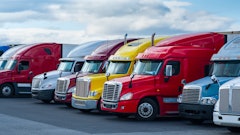Today’s consumers want only the highest-quality foods to be available to them when they shop at their local supermarkets. They don’t think about the enormous effort food logistics companies, growers, processors and manufacturers assume in meeting this expectation requiring that foods remain at precise temperatures throughout the cold supply chain. Technology companies understand these pressures as they develop and manufacture products that help protect foods along every critical control point throughout the cold logistics chain.
Safety and quality issues are among the major trends in the industry today, notes Chuck Carey, vice president of sales for Randall Manufacturing in Elmhurst, IL. “Consumers are loyal to supermarkets offering the highest-quality food products. So our customers are more concerned than ever about maintaining food quality and food safety to earn this loyalty. This means that when they take delivery of food products, they demand assurance that they are receiving them at the right temperature and that temperature set-points have been maintained throughout the cold chain.”
The cost of damaged food products is dramatic. In 2008, total shrink at the retail level was about 2.4 percent of retail sales, reports Elizabeth Darragh, director of food strategic marketing for Sensitech Inc. in Beverly, MA. This includes inventory problems, theft, and perishable shrink. “So when you consider that 1 percent of that 2.4 percent could be caused by perishable shrink, this equates to about $7 billion based on total supermarket sales for 2008 at $547 billion.” She adds that these figures are pretty much stable for the industry, year over year.
Quality is a huge driver in the competitive world in which the food industry participates, states Darragh. “By aiming to control end-user quality, companies have to begin monitoring very early in the cold supply chain so they can understand the treatment their products are being subjected to.
It is not just about making accept-reject decisions; it is more about companies wanting help in understanding where their processes might be breaking down so they can make the appropriate adjustments.” The way they do this is by having the appropriate data to inform them of decisions they must make.
The Big Picture
To assist in the accept-reject decision companies need to make when they take receipt of food products, a recording device is typically placed within the shipment to ensure proper temperatures have been maintained up to the point of receipt. “If I am going to take ownership of a product, I want to be sure I am getting the absolute highest level of quality,” says Darragh.
The cold chain directly impacts not only quality and safety, but consumer trust and loyalty as well. For example, when french fries or frozen dough are temperature-abused, there is no way to determine this until the products are cooked, reports Darragh. “French fries become very greasy from absorbing too much oil. Ice crystals form in frozen dough, creating big holes in the baked product.”
So food companies are demanding a broader perspective in the data captured throughout the cold journey to target any trends signaling potential problems.
“It’s not enough just to look at individual trips in isolation,” explains Darragh. “Progressive vendors want data on the last one hundred or the last thousand trips so they can see if there are trends developing. It becomes a matter of simply getting back to basics around your processes and making sure your trailers are properly pre-cooled and that sure all of your equipment is in optimum working condition.”
Watch That Temperature
By land: We know just how fragile the cold chain is and how each segment along the chain must live up to its responsibility to maintain required temperatures. “Everything could be optimal from the farm to the DC,” notes Carey at Randall. “But when the truck is loaded with little concern for proper procedures regarding open doors during loading or unloading, all of the preceding optimal precautions are undone in an instant.”
Randall offers new user-friendly products for truck doors. “Side-door curtains are not new, but over the years we have made them easier for users,” says Carey. For instance, on very cold days, the strips can freeze and slap workers in the face as they pass through the doors. “Sometimes they would just push them out of the way, leaving the interior of the truck open to the weather. The answer to this problem is the Randall 40-inch wide curtain made with four 10-inch-wide strips. The new curtain has a cable that drivers can pull to open the two middle strips so there is a 20-inch-wide opening. The curtain closes automatically after 30 seconds. So our goal at Randall is to develop practical solutions because people will use products only if they are practical.”
On the waterfront: StarTrak recently introduced an end-to-end-communications product for ocean reefer containers in its ReeferTrak series called
ReeferTrak Mariner.
“One of the major issues in monitoring ocean reefer containers is the challenge measuring temperatures from end to end,” says Tom Robinson, executive vice president of the Morris Plains, NJ, company. “You have to have a device with ubiquitous coverage while the container is on the ship and while it is on land in any given country. The communications platforms have made that much more feasible. The monitoring capability allows ReeferTrak Mariner to measure temperatures when the reefer is on using cellular communications. It also provides various levels of temperature tracking so customers can bring higher-quality products to market.”
Under Control
Control system advancements are providing customers with the ability to fine-tune temperature control for individual food products, reports Mark Fragnito, electronics product manager for Carrier Transicold in Athens, GA. “The systems are configurable for a balance between best temperature control and the highest efficiency for fuel economy because the cost of fuel is on everyone’s mind today.”
Carrier’s new multi-temp refrigeration hybrid unit (Vector 6600MT) provides high refrigeration capacity while delivering up to 20 percent greater fuel efficiency than its predecessor, says Fragnito.
“Customers can control the performance of the reefer in terms of how tightly or loosely temperatures need to be maintained. Our digital data recorder provides access to verify performance and, using data transfer tools such as a PCMCIA card, customers can extract information for a better understanding of equipment performance,” he says.
A new feature available on the control system—Intelliset—allows customers to configure reefers for several different food products. Customers can set parameters such as the required set-points, the amount of temperature drift, and the required air flow for each product. “These are all pre-programmed into their equipment and the driver just picks products from the list and the rest is done by the control system,” adds Fragnito.
Future Vistas
Food companies will continue to need advanced products that are user-friendly, that enhance temperature optimization, and that provide information to assure products are maintained at the right temperature throughout the cold chain.
“You can think about this as an ROI equation,” explains Darragh at Sensitech. “You either save money, or you make money. On the side of saving, you want to maximize your resource allocation by using as few people as possible to get the most out of your operation. You make money by not having to throw away spoiled food and by having it available as high-quality products that attract repeat shoppers. Proper cold chain maintenance can help accomplish both of these things.” d
Rail continues to be the value choice for shippers transporting certain food products. According to Andrew Fuller, director of marketing for Toronto-based CN (Canadian National Railroad), intermodal rail continues to grow in the food and beverage industry.
He notes that the grocery segment represents about 18 percent of CN’s overall business and annual growth in this segment grew year over year by about 5.9 percent from 2006 through 2009.
“We are finding that as food customers examine and redesign their distribution networks, they are evaluating using rail over truck to achieve greater value,” Fuller says.
Here are two new rail services designed to transport food products.
Protective Service
CN recently launched its EcoTherm product, designed to protect food products as they travel cross-country during cold Canadian winters, notes Fuller. In fact, Wal-Mart recognized EcoTherm as a transportation service exemplifying outstanding innovation because of its ability to provide green and clean transportation with a 48-percent fuel savings to the retail giant.
The EcoTherm solution uses well-insulated 40-foot containers with similar specifications to refrigerated containers used in overseas service. The containers have a 2,400 cubic-foot capacity and can carry up to 58,000 pounds of payload.
“We like to ship dense freight with a minimum of 40,000 pounds per shipment of liquid freight,” explains Brant Somerville, marketing manager for domestic intermodal service. “Because the containers are so well-insulated, all we have to do is heat up the products at origin to normal room temperature, around 20 degrees Celsius. Products can then travel across the country without requiring further heating to protect them from cold weather.”
This kind of service is best suited for heavy grocery products, especially liquid products.
Fuller notes that about shipments using this service are protected from freezing for up to nine days without requiring any additional heating. “We are fortunate to have one of the fastest service grids in North America, allowing us to reach western Canada within four to five days.”
Because this service uses 40-foot containers, there is no need to invest in blocking and bracing costs required if 53-foot-long containers were used, notes Somerville. “Shippers can save up to $300 per container on average in blocking and bracing expenses. The freight moving in these 40-foot boxes almost always weighs out and if you were using a 53-foot box, so you would need to block and brace the shipment because it would weigh out before reaching full load capacity. This means you’d be shipping 13 feet of empty space.”
Wal-Mart Canada recently awarded CN its prestigious Innovator of the Year honor in recognition of CN’s continuing support of customers’ needs focused on leveraging rail while combining non-rail transportation solutions. CN’s truck-like and cost-saving service also delivers a soft environmental impact over that of truck transportation. “EcoTherm is designed not to require additional fuel to protect products from cold Canadian winters,” says Fuller.
Cold Train
In conjunction with BNSF Railway, Rail Logistics recently introduced a cold train service that runs from the intermodal terminal at the inland port of Quincy, WA, to Chicago. The service, called the PNW Chicagoland Express, is offered six days a week, delivering to warehouses within 200 miles of Chicago in just four days.
Using 53-foot refrigerated containers that travel on the BNSF network, the cold train is designed to transport chilled cargo, particularly apples, onions, potatoes, cherries, nectarines, peaches, and a wide range of frozen fruits and vegetables. It is a daily refrigerated intermodal pipeline connecting western growers, producers, packers, and co-ops with Midwestern cold storage companies, buyers, wholesalers and retailers. The service is expected to be competitive with truck transit in both cost and speed to market.
Rail Logistics is the company responsible for transporting containers from the port. Rail Logistics is also responsible for signing up growers, processors, purchasers, brokers, food distributors and grocery chains. —A.T.
Transform A Cold Chain Into An Advantage
By Christian Schenk
Food now travels further than ever from farm to fork. As local farms and main street restaurants have given way to corporate entities and national chains, food has gone from traveling across town to traveling across the country. As we all know, much of that food must be properly refrigerated or food becomes susceptible to bacteria. Just one tainted shipment could cost a company its reputation, its future orders and millions of dollars in lost sales and liability.
Fleets face increasing pressure to follow strict temperature standards to ensure that food is not spoiled during transport. On the cost-saving side, they must also optimize reefer fuel usage and overall reefer fleet utilization, among other issues.
Bottom line: there are no second chances when it comes to the quality of the food people eat, many producers and retailers are now demanding that the fleets that transport their goods—whether traveling across town or across country—provide real-time data, including proof of temperature and knowing where their products are at all times.
A reefer management solution enables fleets to manage trucks and untethered reefers. The right system can provide a real-time look at both tractors and trailers within a single view. It also provides instant access to important information such as proof of temperature, door status and trailer locations and also helps ensure temperature compliance.
For example, XATA’s new reefer management solution integrates with XATANET and provides fleets with tools to track temperature data throughout a delivery and to ensure they are getting the most efficient use from their reefer fleets. Having instant access to this information helps fleets increase supply chain visibility and intelligent reefer management solutions also help with the following:
Reduce costs: Fleets can reduce fuel costs by closely monitoring fuel consumption, door status and temperature status with reefer management. Other cost-reducing factors include reduction of maintenance costs through preventative alerts and reducing food spoilage liability.
Increase customer satisfaction: Customers want to know from shippers: “Did my products arrive on time and were they kept at the proper temperature the entire time they were in your possession?” The right reefer management software can provide this information in easy-to-read graphs and charts.
Improve safety and compliance: Knowing the exact location of products ensures compliance with government and industry regulations.
Address driver performance: Data provided can give visibility in to driver behavior such as unscheduled stops, unsecured trailer doors and idling. Fleet managers can put this information to use immediately—talking with drivers to be sure they understand what is required of them, and, if necessary, providing additional training.
Reefer management provides the power to manage an entire fleet of trucks and reefers in one system. With a single-view of in-cab and reefer fleet data provided by the right reefer management system, managers have the right information at their fingertips to reduce delivery costs and improve customer service.
Schenk is vice president, product marketing, XATA Corp., Minneapolis.


























